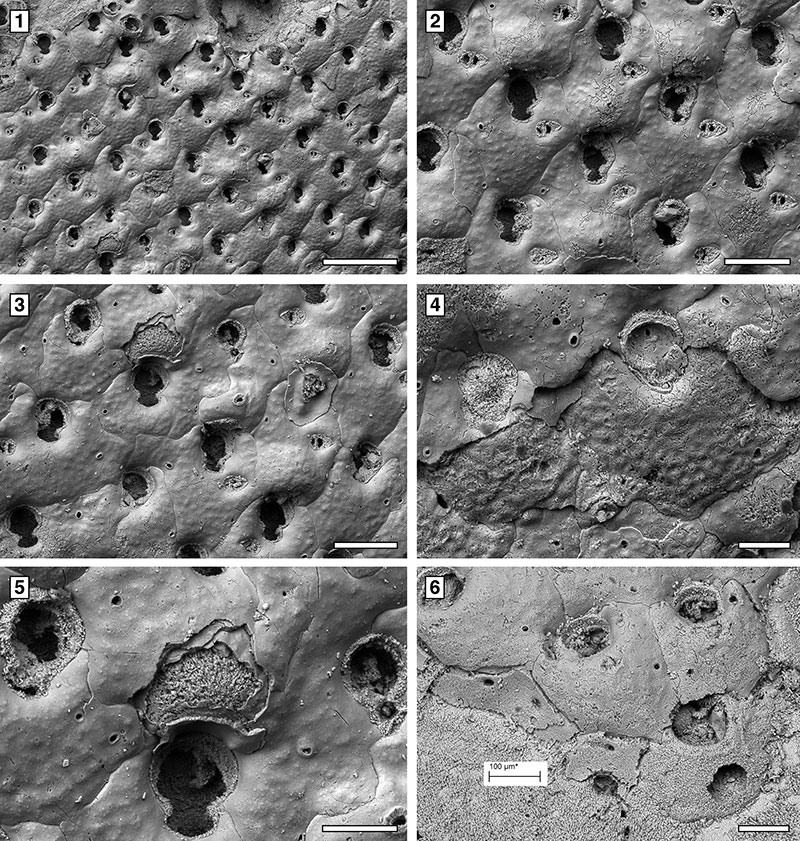FIGURE 1. Location of the collecting locality (Phase 10 excavations of the SMR Aggregates quarries), northeast of Sarasota, Florida.

FIGURE 2. Overview of the Neogene and Quaternary stratigraphic units in Florida (modified slightly from Bryan and Means, 2014, figure 4), and detailed stratigraphic nomenclature of the Tamiami Formation units used for the APAC and SMR Aggregates quarries in Sarasota and Manatee Counties taken from Zullo and Harris (1992) incorporating and slightly modifying the APAC stratigraphic units of Petuch (1982).
modifying the APAC stratigraphic units of Petuch (1982).
FIGURE 3. Anomia simplex d’Orbigny, 1853

FIGURE 4. Oncousoecia sp., UF 305758 (Shell 111), Pliocene, lower Tamiami Formation Units 10/11. 1, general view of the ribbon-like colony (400 µm). 2, close-up of the left lobe (200 µm). 3, part of the colony including several autozooids, a broken gonozooid and basal lamina with two rows of kenozooids (200 µm). 4, close-up of an autozooid with elliptical aperture and wrinkled, pseudoporous frontal wall (100 µm). 5, part of the colony with complete gonozooid and ooeciopore and distal fringe of basal lamina including several rows of kenozooids (400 µm). 6, close-up of the gonozooid (200 µm).

FIGURE 5. Acanthodesia cf. denticulata (Busk, 1856), UF 305759 (Shell 370), Pliocene, lower Tamiami Formation Units 10/11. 1, general view of the small colony available (200 µm). 2, close-up of the outline of the twinned ancestrula (see arrows) and first budded zooids (100 µm). 3, close-up of autozooids with cryptocystal spine-like projections in the opesia (100 µm).

FIGURE 6. Acanthodesia sp., UF 305760 (Shell 500), Pliocene, lower Tamiami Formation Units 10/11. 1, general view of the extensive sheet-like colony (2 mm), with asterisks indicating kenozooids and/or irregularly shaped autozooids forming at the edges of abutting lobes/colonies. 2, group of autozooids (400 µm). 3, close-up of slender autozooids placed at row bifurcation (200 µm).

FIGURE 7. Osburnea aff. biscuta (Osburn, 1950), UF 305761a, b (Shell 374), Pliocene, lower Tamiami Formation Units 10/11. 1, general view of the small colony (a) (400 µm). 2, close-up of autozooids with arrows showing two proximomedial and four distolateral spine bases (200 µm). 3, group of autozooids including those at row bifurcation (200 µm). 4, tilted view of small, fan-shaped colony (b) (200 µm).

FIGURE 8. Amphiblestrum constrictum Ulrich and Bassler, 1904, Pliocene, lower Tamiami Formation Units 10/11. 1-3, UF 305762 (Shell 5). 1, general view of an extensive, circular, sheet-like colony overgrown by a barnacle (1 mm). 2, close-up of a partially overgrown tatiform ancestrula and first budded autozooids (100 µm). 3, group of autozooids including colony growing edge, showing pore-chamber windows and adventitious avicularia (500 µm). 4-6, UF 305763 (Shell 329). 4, group of autozooids showing intramural buds and closure plates (200 µm), with arrows indicating distolateral oral spine bases. 5, close-up of adventitious avicularia (200 µm). 6, group of ovicellate zooids (200 µm). 7, UF 305764 (Shell 28), close-up of the tatiform ancestrula and first budded zooids (100 µm).

FIGURE 9. 1-3, Amphiblestrum constrictum Ulrich and Bassler, 1904, holotype USNM 68459, Miocene, Maryland, USA. 1, part of the colony (200 µm). 2, close-up of an autozooid with four distolateral spine bases and an ovicell (100 µm). 3, close-up of the adventitious avicularium (100 µm). 4-6, Amphiblestrum tenuiparietis Canu and Bassler, 1923, holotype USNM 68460, Pliocene, Florida, USA. 4, part of the colony (200 µm). 5, close-up including autozooids, an ovicellate zooid and an adventitious avicularium (200 µm). 6, close-up of a zooid with incomplete ovicell and distolateral spine bases (100 µm).

FIGURE 10. Aplousina grandis (Canu and Bassler, 1923), Pliocene, lower Tamiami Formation Units 10/11. 1-3, UF 305765 (Shell 13). 1, general view of an extensive, sheet-like colony (1 mm). 2, group of ovicellate and non-ovicellate zooids, some with intramural buds (500 µm). 3, close-up of three ovicellate zooids (400 µm). 4-6, UF 305766 (Shell 504). 4, irregularly shaped kenozooids formed along the encounter edge of two colonies (500 µm). 5, small colony with ancestrula (500 µm). 6, close-up of the ancestrula and first budded autozooids (200 µm).

FIGURE 11. Cauloramphus? sp., UF 305767a, b (Shell 324), Pliocene, lower Tamiami Formation Units 10/11. 1, general view of the small colony (a) (200 µm). 2, close-up of an autozooid showing the numerous circumopesial spine bases (60 µm). 3, close-up of two autozooids with a large gap in between likely to have been occupied by the connecting tubular chambers typical of some species of Cauloramphus (100 µm). 4, tilted view of small colony (b) (200 µm). 5, group of tilted autozooids, the top right autozooid showing cut-off tubular chambers on the lateral walls (100 µm). 6, close-up of some autozooids (100 µm).

FIGURE 12. Copidozoum cf. parvirostris (Canu and Bassler, 1923) comb. nov., UF 305768 (Shell 12), Pliocene, lower Tamiami Formation Units 10/11. 1, general view of the colony (400 µm). 2, group of autozooids and interzooidal avicularia (200 µm). 3, close-up of an interzooidal avicularium (100 µm). 4, intramural buds (200 µm).

FIGURE 13. Floridina regularis Canu and Bassler, 1923, Pliocene, lower Tamiami Formation Units 10/11. 1-2, UF 305769 (Shell 1). 1, group of autozooids and vicarious avicularia (400 µm). 2, close-up of an autozooid flanked by two vicarious avicularia (200 µm). 3, UF 305770 (Shell 18), group of fertile zooids (200 µm). 4, UF 305771 (Shell 22), irregularly shaped kenozooids formed at the encounter edge between two abutting colonies (400 µm). 5, UF 305772 (Shell 24), ancestrula and early astogeny (300 µm). 6, UF 305770 (Shell 18), intramural buds (200 µm). 7, UF 305773 (Shell 324), closure plates with scars of the operculum (200 µm).

FIGURE 14. Micropora stellata sp. nov., Pliocene, lower Tamiami Formation Units 10/11. 1-3, paratype UF 305775 (Shell 31). 1, general view of the colony (600 µm). 2, close-up of two autozooids with prominent knobs on each side of the orifice and a distal, interzooidal avicularium (200 µm). 3, close-up of pseudopores with radiating denticulation giving them a star-shaped appearance (50 µm). 4-6, holotype UF 305774 (Shell 33). 4, group of ovicellate zooids (200 µm). 5, close-up of an ovicellate zooid (200 µm). 6, part of the colony with closure plates (400 µm).

FIGURE 15. 1-2, Micropora robusta Cook, 1985, holotype NHMUK 1972.3.3.1, Recent, off Cape Coast, Ghana (27 m depth). 1, group of ovicellate and non-ovicellate zooids, some with closure plates, and interzooidal avicularia (400 µm). 2, close-up of an ovicellate zooid and an interzooidal avicularium (200 µm). 3-4, Micropora coriacea sensu Canu and Bassler (1923), USNM 68480, Pleistocene, California, USA. 3, group of autozooids and interzooidal avicularia (500 µm). 4, close-up of some autozooids and an interzooidal avicularium (200 µm).

FIGURE 16. Puellina scripta (Reuss, 1848), UF 305776 (Shell 10), Pliocene, lower Tamiami Formation Units 10/11. 1, general view of part of an extensive, sheet-like colony (1 mm). 2-3, groups of ovicellate and non-ovicellate zooids and interzooidal avicularia (200 µm). 4, autozooids with peculiar preservation and closure plates with opercular scars (200 µm).

FIGURE 17. Puellina scripta (Reuss, 1848), UF 305777 (Shell 343), Pliocene, lower Tamiami Formation Units 10/11. 1, general view of part of an extensive, sheet-like colony (500 µm). 2, groups of ovicellate zooids showing a median suture and faint radiating costae (200 µm). 3, autozooids with more extensive, smooth gymnocyst proximally, reparative buds and interzooidal avicularia (200 µm). 4, autozooids at colony growth edge showing pore-chamber windows (400 µm). 5, close-up of ovicellate and non-ovicellate zooids showing the robust oral spines and interzooidal avicularium with intramural bud (200 µm). 6, group of autozooids and interzooidal avicularium intramurally budded (200 µm).

FIGURE 18. Puellina scripta (Reuss, 1848), Pliocene, lower Tamiami Formation Units 10/11. 1-2, UF 305778 (Shell 22). 1, tatiform ancestrula and early astogeny (500 µm). 2, close-up of the tatiform ancestrula and periancestrular zooids (200 µm). 3-4, UF 305779 (Shell 3). 3, costulate kenozooid as regeneration of the ancestrula and first budded autozooids (200 µm). 4, close-up of the costulate kenozooid regenerated from the tatiform ancestrula (100 µm).

FIGURE 19. Spiniflabellum laurae sp. nov., holotype UF 305780 (Shell 30), Pliocene, lower Tamiami Formation Units 10/11. 1, general view of the small colony (400 µm). 2, group of autozooids (200 µm). 3, close-up of the orifice overarched by the distalmost pair of costae forming an eight-shaped pseudospiramen and bearing distally two platy elements terminating in two coalescent spines (100 µm). 4, autozooids at colony growing edge showing pore-chamber windows and orifice (200 µm).

FIGURE 20. Trypostega composita sp. nov., Pliocene, lower Tamiami Formation Units 10/11. 1-2, holotype UF 305782 (Shell 21). 1, view of part of the colony with two subcolonies produced by frontal budding (500 µm). 2, group of autozooids and clustered zooeciules (200 µm). 3-7, paratype UF 305783 (Shell 261). 3, close-up of the orifice of a non-ovicellate autozooid (40 µm). 4, group of ovicellate and non-ovicellate zooids showing the dimorphic orifices (200 µm). 5, group of ovicellate and non-ovicellate zooids and zooeciules (500 µm). 6, growing edge of a subcolony showing pore-chamber windows and zooeciules in clusters (400 µm). 7, group of ovicellate and non-ovicellate zooids (200 µm). 8, paratype UF 305784 (Shell 17), autozooids, some with closure plates (200 µm).

FIGURE 21. Reptadeonella umbilicata (Lonsdale, 1845) comb. nov., Pliocene, lower Tamiami Formation Units 10/11. 1-3, UF 305785 (Shell 101). 1, view of part of an extensive, unilaminar colony including the growing edge (1 mm). 2, group of autozooids with or without the suboral avicularium and a fertile zooid in the centre (200 µm). 3, close-up of the fertile zooid (100 µm). 4-5, UF 305786 (Shell 18). 4, view of part of a multilaminar colony (1 mm). 5, close-up of an autozooid with intramural buds in the suboral avicularium (100 µm). 6, UF 305787 (Shell 19), group of autozooids mostly lacking a suboral avicularium and calcification spreading from marginal areolar pores (100 µm).

FIGURE 22. Reptadeonella umbilicata (Lonsdale, 1845) comb. nov., holotype NHMUK D53195, Pliocene, Petersburg, Virginia, USA. 1, general view of the colony (1 mm). 2, close-up of an autozooid lacking the suboral avicularium (100 µm).

FIGURE 23. Celleporaria sp., Pliocene, lower Tamiami Formation Units 10/11. 1-3, UF 305788 (Shell 31). 1, general view of a multilaminar, mounded colony (600 µm). 2, close-up of autozooids with two, distolateral, oral spine bases and suboral avicularia (200 µm). 3, close-up of an interzooidal avicularium (100 µm). 4, UF 305789 (Shell 11), general view of a mounded colony with several interzooidal avicularia (500 µm). 5, ovicellate zooids (200 µm).

FIGURE 24. Cyclocolposa perforata Canu and Bassler, 1923, Pliocene, lower Tamiami Formation Units 10/11. 1-2, UF 305791 (Shell 36). 1, view of part of an extensive colony with most of the zooids ovicellate (500 µm). 2, group of ovicellate and non-ovicellate zooids and kenozooids (400 µm). 3-5, UF 305792 (Shell 10). 3, tatiform ancestrula and early astogeny (400 µm). 4, close-up of the tatiform ancestrula and first budded autozooids (200 µm). 5, close-up of autozooids at the colony growing edge showing pore chamber windows (200 µm).

FIGURE 25. 1-3, Cyclocolposa perforata Canu and Bassler, 1923, syntype USNM 68617, early Pleistocene, South Carolina, USA. 1, group of autozooids (200 µm). 2, group of ovicellate zooids (500 µm). 3, close-up of an ovicellate and a non-ovicellate zooid (200 µm). 4-6, Cyclocolposa tenuiparietis Canu and Bassler, 1923, syntype USNM 68618, Pliocene, Florida, USA. 4, group of autozooids (200 µm). 5, group of autozooids, one with a latero-oral avicularium (200 µm). 6, group of zooids with incomplete ovicells (200 µm).

FIGURE 26. Hippopleurifera mucronata (Smitt, 1873), UF 305793 (Shell 29). Pliocene, lower Tamiami Formation Units 10/11. 1, general view of the colony (1 mm). 2, group of autozooids at colony growing edge showing pore-chamber windows (400 µm). 3, group of ovicellate zooids (400 µm). 4, close-up of ovicellate zooids, one with an adventitious avicularium (200 µm).

FIGURE 27. Stephanollina vorax (Canu and Bassler, 1923), Pliocene, lower Tamiami Formation Units 10/11. 1-3, UF 305794 (Shell 34). 1, general view of the colony (1 mm). 2, group of autozooids with different types of adventitious avicularia (200 µm). 3, close-up of an autozooid with a fusiform avicularium (100 µm). 4-5, UF 305795 (Shell 35). 4, general view of an ‘old’ part of a colony (200 µm). 5, close-up of two autozooids showing the cormidial secondary orifice (100 µm). 6-7, UF 305796(Shell 22). 6, group of autozooids at colony growing edge showing pore-chamber windows (200 µm). 7, close-up of two autozooids (100 µm).

FIGURE 28. Stephanollina vorax (Canu and Bassler, 1923), syntypes. 1, USNM 651310, Pleistocene, South Carolina, USA, group of autozooids (200 µm). 2, USNM 651312, Pliocene, North Carolina, USA, group of autozooids with arrows indicating orifices in which condyles are preserved and asterisk indicating a fusiform avicularium partially covered by secondary calcification (200 µm).

FIGURE 29. Smittoidea maleposita (Canu and Bassler, 1923) comb. nov., Pliocene, lower Tamiami Formation Units 10/11. 1-5, UF 305797 (Shell 17). 1, part of a multilaminar colony (500 µm). 2, close-up of two autozooids with median, suboral avicularium and closure plate (100 µm). 3, close-up of an autozooid with avicularium at the proximolateral corner (200 µm). 4, close-up of the orifice (50 µm). 5, close-up of an ovicell (100 µm). 6, UF 305798 (Shell 258), close-up of an ovicell (100 µm).

FIGURE 30. Smittoidea maleposita (Canu and Bassler, 1923) comb. nov., syntype, USNM 68641, Pleistocene, Florida, USA. 1, group of autozooids (200 µm). 2, close-up of the orifice and suboral avicularium (50 µm).
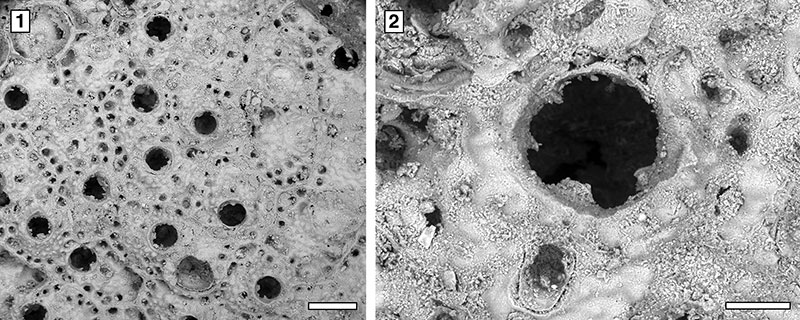
FIGURE 31. Metroperiella reversa (Ulrich and Bassler, 1904) comb. nov., Pliocene, lower Tamiami Formation Units 10/11. 1-2, UF 305799 (Shell 343). 1, group of ovicellate and non-ovicellate zooids (500 µm). 2, close-up of two orifices with suboral avicularia and an ovicell (100 µm). 3, UF 305800 (Shell 23), group of zooids with closure plates (200 µm). 4, UF 305801 (Shell 3), group of autozooids and irregularly shaped kenozooids filling the gap resulting from self-overgrowth (1 mm). 5, UF 305802 (Shell 461), irregularly shaped kenozooids at the junction between two abutting colonies (1 mm). 6-7, UF 305803 (Shell 2). 6, tatiform ancestrula and early astogeny (400 µm). 7, close-up of the tatiform ancestrula and first budded zooid (200 µm).

FIGURE 32. Watersipora? sp., UF 305804 (Shell 427), Pliocene, lower Tamiami Formation Units 10/11. 1, part of a colony (500 µm). 2, group of autozooids (200 µm). 3, close-up of an orifice (50 µm). 4, ?kenozooids lacking an aperture (200 µm).
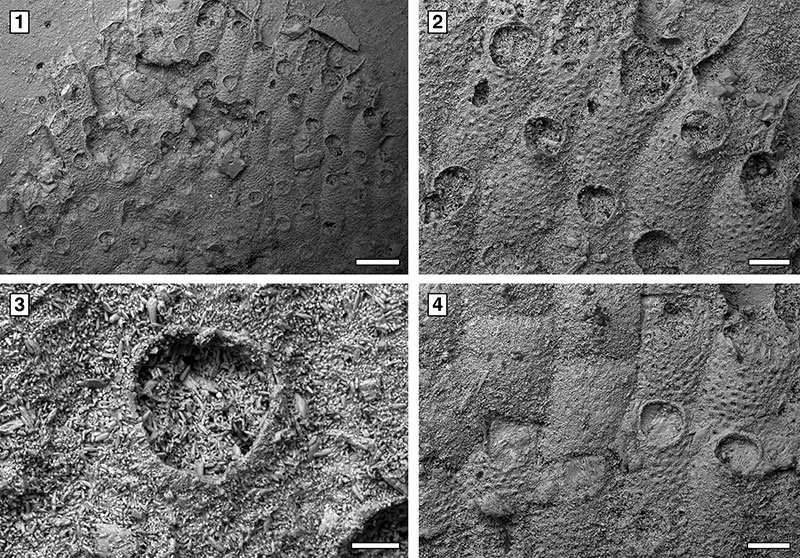
FIGURE 33. Stylopoma leverhulme Di Martino, Taylor, and Portell, 2017, UF 305805 (Shell 27), Pliocene, lower Tamiami Formation Units 10/11. 1, general view of a multi-layered colony (1 mm). 2, group of autozooids (200 µm). 3, close-up of an autozooid with an avicularium lateral to the orifice (100 µm). 4, close-up of two orifices (50 µm). 5-6, autozooids with closure plates (200 µm).
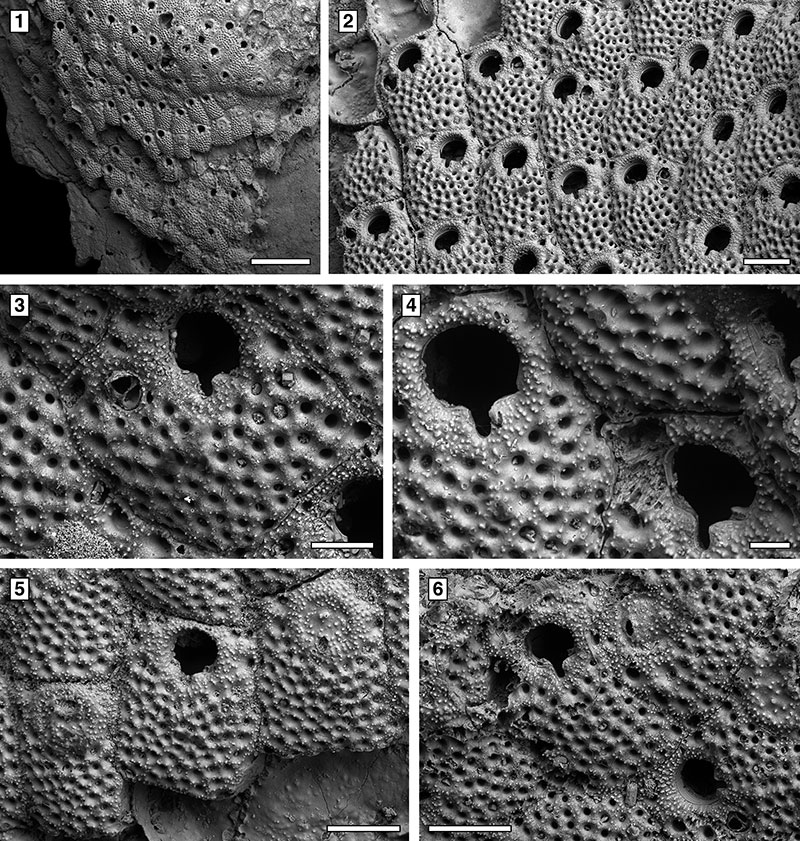
FIGURE 34. Cycloperiella rubra Canu and Bassler, 1923, Pliocene, lower Tamiami Formation Units 10/11. 1-3 UF 305806 (Shell 15). 1, general view of a colony (500 µm). 2, group of autozooids, some with avicularium lateral to the orifice (200 µm). 3, close-up of the orifice (100 µm). 4-6, UF 305807 (Shell 28). 4, group of ovicellate and non-ovicellate zooids (500 µm). 5, group of ovicellate zooids (300 µm). 6, close-up of an ovicell with peristomial collar (100 µm).
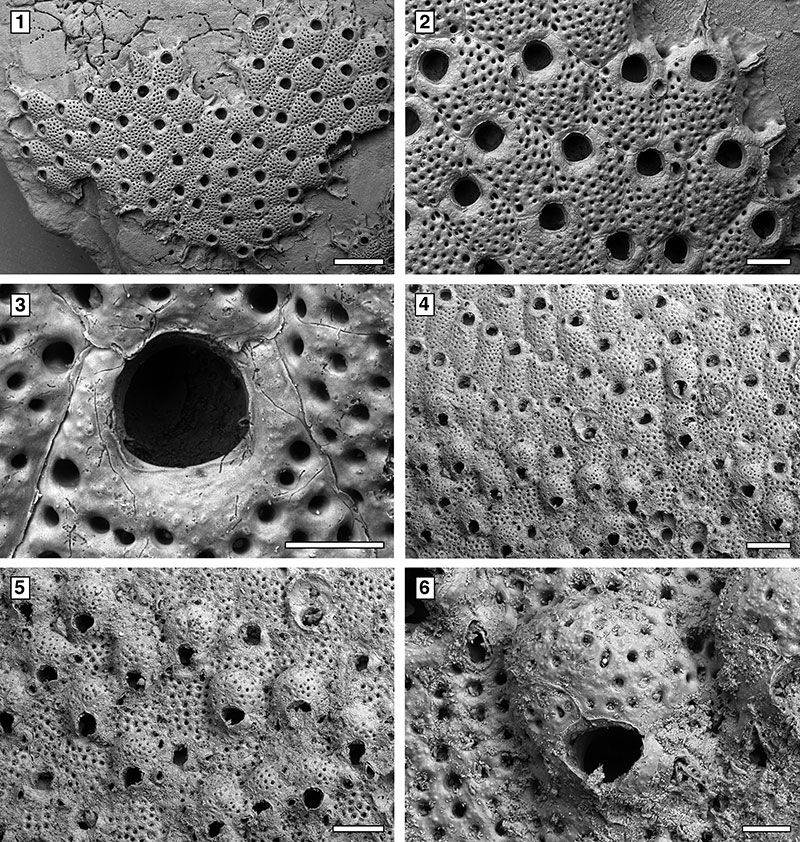
FIGURE 35. Cycloperiella rubra Canu and Bassler, 1923, syntype USNM 68620, Pliocene, North Carolina, USA. 1, group of autozooids (200 µm). 2, ovicellate zooids (200 µm).
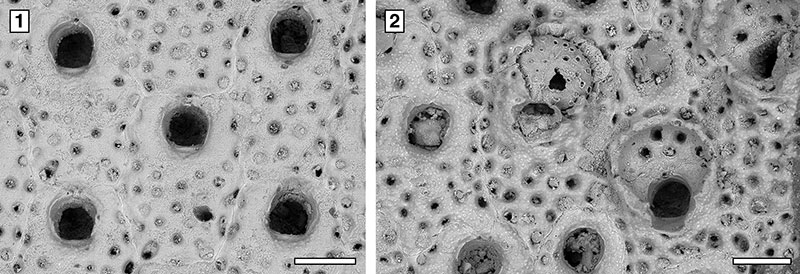
FIGURE 36. Hippaliosina rostrigera (Smitt, 1873), UF 305808 (Shell 22), Pliocene, lower Tamiami Formation Units 10/11. 1, tilted view of a colony (400 µm). 2, group of autozooids with adventitious avicularia (200 µm).
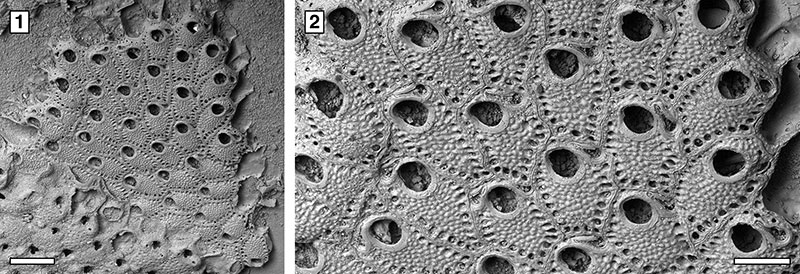
FIGURE 37. Microporella sarasotaensis sp. nov., Pliocene, lower Tamiami Formation Units 10/11. 1-5, holotype UF 305809 (Shell 374). 1, general view of part of the colony (1 mm). 2, group of autozooids (500 µm). 3, close-up of the cribrate ascopore (50 µm). 4, group of ovicellate zooids (400 µm). 5, close-up of an ovicell (100 µm). 6, paratype UF 305810 (Shell 14), close-up of two autozooids (200 µm). 7, paratype UF 305811 (Shell 21), dissolution or abrasion of some zooids (400 µm).
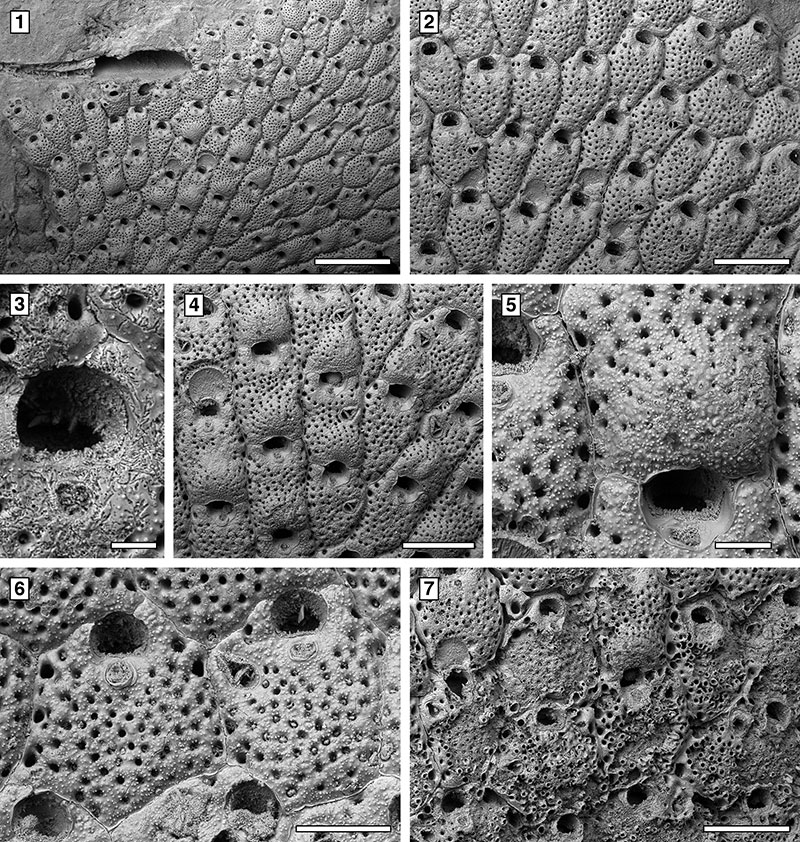
FIGURE 38. Microporella tamiamiensis sp. nov., Pliocene, lower Tamiami Formation Units 10/11. 1-6, holotype UF 305812 (Shell 3). 1, general view of part of the colony (1 mm). 2, group of ovicellate and non-ovicellate zooids (500 µm). 3, group of zooids at colony growing edge showing pore-chamber windows (200 µm). 4, close-up of an orifice with three oral spine bases (50 µm). 5, group of tilted ovicellate zooids showing the lateral flaps (400 µm). 6, close-up of zooids showing pore-chamber windows (200 µm). 7-8, paratype UF 305813 (Shell 29), group of zooids showing a more developed proximal rim of the ascopore ( 7, 500 µm; 8, 400 µm).
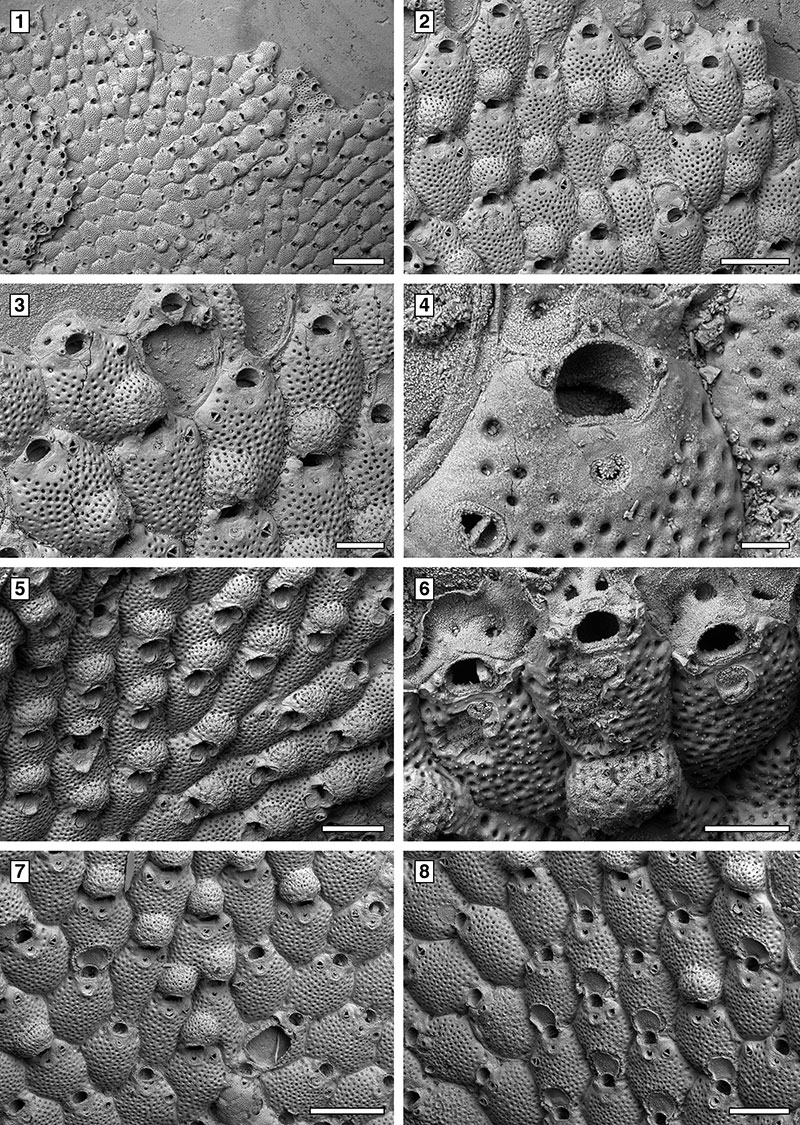
FIGURE 39. Microporella cf. pontifica Osburn, 1952, Pliocene, lower Tamiami Formation Units 10/11. 1-4, UF 305814 (Shell 15). 1, general view of part of the colony (500 µm). 2, group of ovicellate and non-ovicellate zooids (200 µm). 3, group of ovicellate zooids, one on the top left with a peristomial bridge (200 µm). 4, close-up of the orifice (with cormidial cusps and lobes in the position of oral spine bases) and denticulate ascopore (40 µm). 5, UF 305815 (Shell 30), group of autozooids, some with paired avicularia (400 µm). 6, UF 305816 (Shell 12), dissolution or abrasion of some zooids (200 µm).
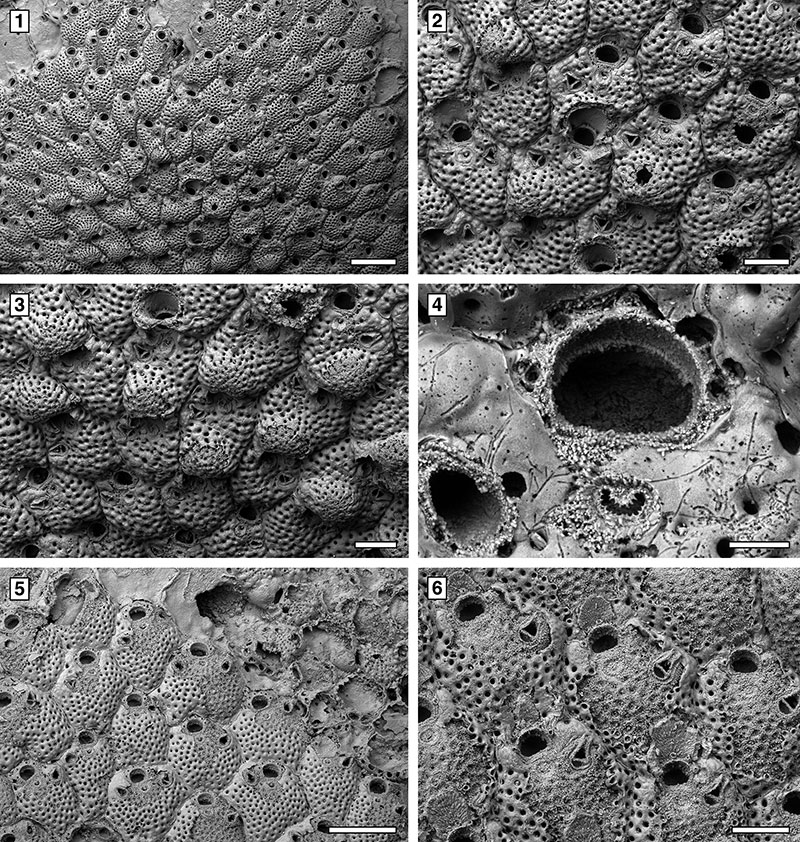
FIGURE 40. Pourtalesella chiarae sp. nov., Pliocene, lower Tamiami Formation Units 10/11. 1-2, holotype UF 305817 (Shell 3). 1, general view of the multilaminar colony (1 mm). 2, group of autozooids (200 µm). 3-5, paratype UF 305818 (Shell 25). 3, close-up of an orifice (40 µm). 4, group of ovicellate and non-ovicellate zooids (400 µm). 5, close-up of an ovicell (60 µm). 6-7, paratype UF 305819 (Shell 26). 6, group of zooids, one ovicellate and one with a closure plate (200 µm). 7, close-up of an ovicell (60 µm). 8-9, paratype UF 305820 (Shell 119). 8, ancestrula and early astogeny (200 µm). 9, close-up of the ancestrula and first budded autozooids (100 µm).
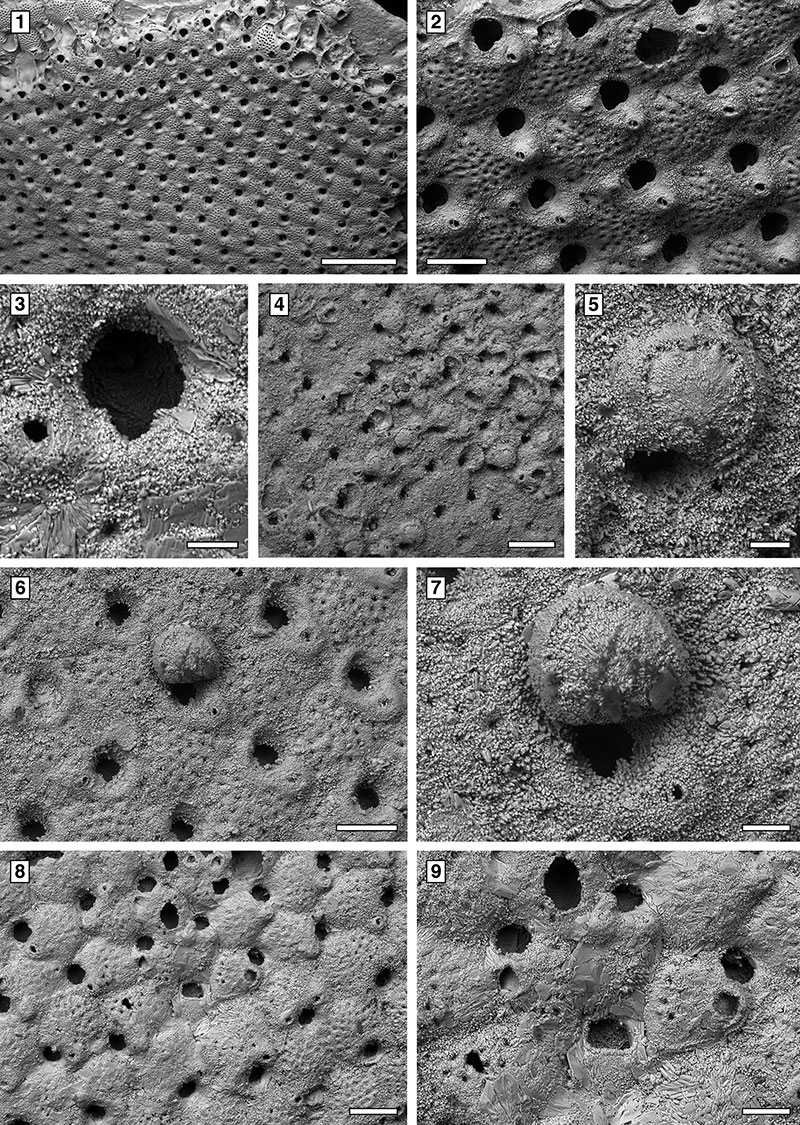
FIGURE 41. Stephanosella biaperta Michelin, 1842 sensu Canu and Bassler (1923). 1-2, USNM 68544. 1, group of autozooids (200 µm). 2, close-up of the orifice (100 µm). 3-4, USNM 68546. 3, group of zooids, some with incomplete ovicells (200 µm). 4, close-up of an orifice, lateral avicularia and incomplete ovicell (50 µm).
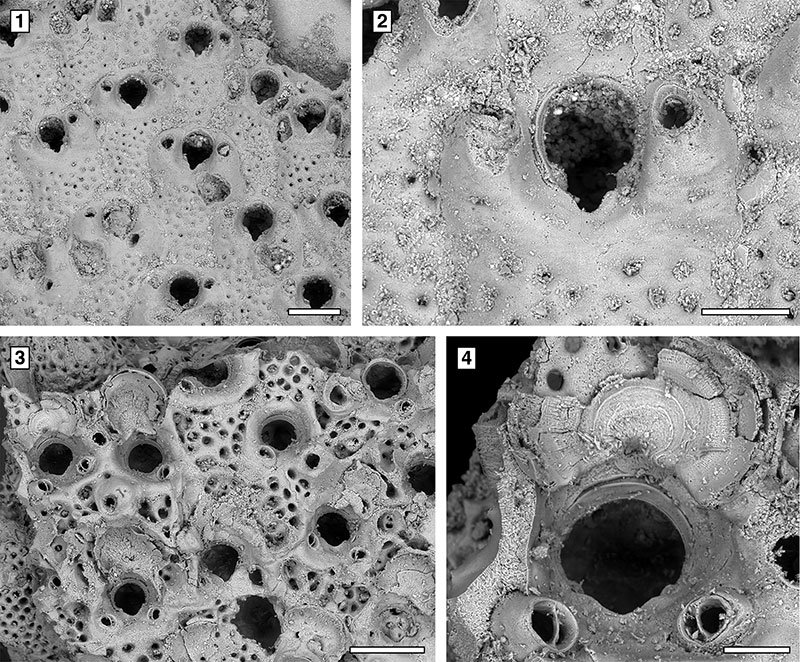
FIGURE 42. Plesiocleidochasma cf. vestitum (Canu and Bassler, 1923), Pliocene, lower Tamiami Formation Units 10/11. 1-5, UF 305821 (Shell 14). 1, group of ovicellate and non-ovicellate zooids (500 µm). 2, close-up of three ovicellate zooids (200 µm). 3, group of zooids with secondary calcification spreading from marginal areolar pores (200 µm). 4, autozooids with closure plates (100 µm). 5, damaged ovicell showing the superposition of calcareous layers (100 µm). 6, UF 305822 (Shell 11), tatiform ancestrula and first budded zooids (100 µm).
